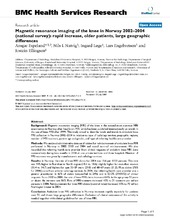| dc.description.abstract | Background: Magnetic resonance imaging (MRI) of the knee is the second most common MRI examination in Norway after head/brain MRI. Little has been published internationally on trends in the use of knee MRI after 1999. This study aimed to describe levels and trends in ambulant knee MRI utilisation in Norway 2002–2004 in relation to type of radiology service, geographic regions, number of MRI-scanners, patient age and gender, and type of referring health care provider. Methods: We analysed administrative data on all claims for reimbursement of ambulant knee MRI performed in Norway in 2002, 2003 and 2004 and noted nominal reimbursement. We also recorded the referring health care provider from clinical requests of ambulant knee MRI done consecutively during two months in 2004 at one private institute and three hospitals. Number of MRI-scanners was given by manufacturers and radiology services. Results: In Norway, the rate of knee MRI claims for 2004 was 15.6 per 1000 persons. This rate was 74% higher in East than in North region (18.4 vs. 10.6), slightly higher for men than women (16.4 vs. 14.7) and highest for ages 50–59 years (29.0) and 60–69 years (21.2). Most claims (76% for 2004) came from private radiology services. In 2004, the referring health care provider was a general practitioner in 63% of claims (unspecified in 24%) and in 83.5% (394/472) of clinical requests. From 2002 to 2004, the rate of knee MRI claims increased 64%. In the age group 50 years or above the increase was 86%. Rate of MRI-scanners increased 43% to 21 scanners per million persons in 2004. Reimbursement for knee MRI claims (nominal value) increased 80% to 70 million Norwegian kroner in 2004. Conclusion: Ambulant knee MRI utilisation in Norway increases rapidly especially for patients over 50, and shows large geographic differences. Evaluation of clinical outcomes of this activity is needed together with clinical guidelines for use of knee MRI. | en_US |
